This course is part of the Metal Architecture Academy
When you envision distinctive, notable, and award-winning buildings, do insulated metal panels come to mind? They should. Some of the most interesting and iconic architecture built today—from the Chase Center in San Francisco, to Hilton’s 123 Carnack Hotel in Chicago, to Austin Community College—stand out precisely because of the artful deployment of insulated metal panels.
After the qualities of insulated metal panels (IMPs) are understood, from their environmental benefits to their ease of installation and the potential for high design, it makes sense that competition judges who are themselves accomplished architects have taken notice.

Photo courtesy of Jason O’Rear Photography
Some of the most iconic architecture built today stands out because of the artful deployment of their insulated metal skins, as seen on the facade of San Francisco's Chase Center.
“Each year when the Metal Construction Association calls for submissions for our Chairman’s Awards competition, we are truly impressed by the projects that are submitted and the creativity of the architects,” said Robert (R.C.) Antal, Insulated Panel Manager at ATAS International, Inc., and MCA's IMP Alliance Chair. “The competition clearly shows the design industry’s growing appreciation for insulated metal panels.”
As we’ll see from the following striking and award-winning buildings designed and constructed with IMPs, these unique building components are being used in a wide variety of noteworthy buildings.
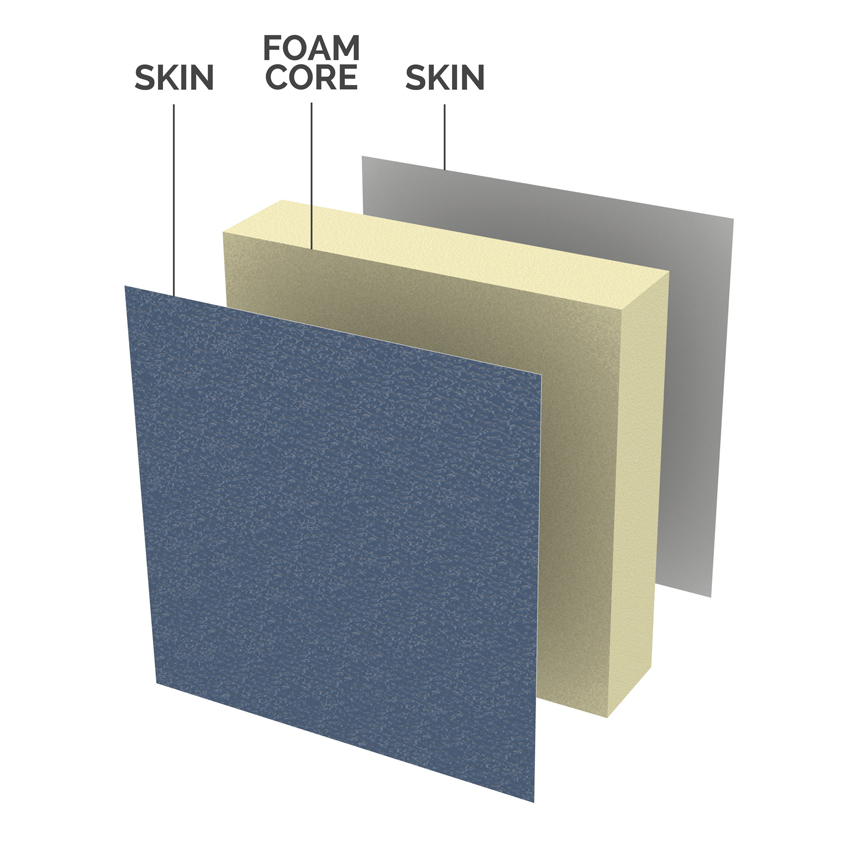
Sintered stone surfaces are available in many colors and finishes, providing durability, resilience, and aesthetic appeal.
What are Insulated Metal Panels?
Insulated Metal Panels (IMPs) are lightweight composite exterior wall and roof panels with metal skins and an insulating foam core. These panels have superior insulating properties, and their outstanding spanning capabilities and one-pass installation makes them quick to install, saving costs compared to other wall assemblies. IMPs are available in a wide variety of colors, widths, profiles, and finishes, enabling virtually any aesthetic desired for walls and roofs.
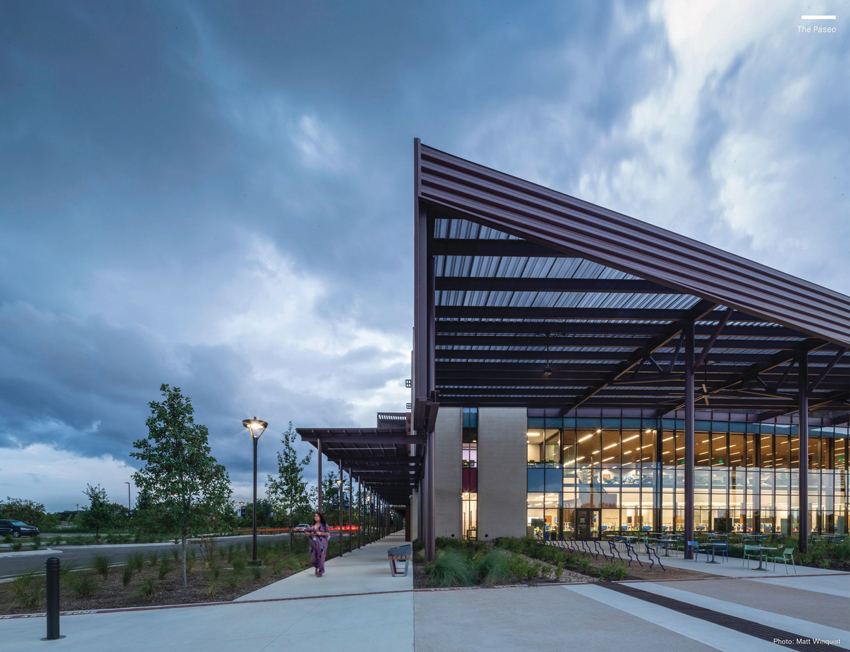
Photo courtesy of Matt Winquist
Austin Community College San Gabriel Campus, Leander, Texas
Design Potential
Architectural IMPs have the normal attributes of other commercial and industrial segments such as high insulation values, speed of build, and vertical and horizontal applications, but incorporate options such as custom shapes and widths, special custom colors and finishes, and custom fabrication including but not limited to bent corners, curved panels, and trimless ends. Architectural IMPs offer options that can incorporate panels that integrate with windows, louvers, sunshades, or other integrated products to offer total building envelope solutions. IMPs provide architects freedom to create their unique building designs.
A fitting example is the award-winning Austin Community College, which won a metal building design competition in the colleges and universities category. The decision was unanimous among the panel of architects: Steven G. Blye of Legat Architects, Steven Ginn of Steven Ginn Architects, and Paul Mankins of Substance Architecture.
The design team was challenged to create an attractive, inviting campus in a 100-acre cow pasture. Historical building forms, patterns and materials of Central Texas—simple geometries, lots of shading, and materials such as limestone, metal, wood, and glass—all came together in an architecture rooted in place and time.
The selection of materials was inspired by unique regional assets: the ranch, the creek, and the railroad. Corrugated, flat, and ribbed metal panels reflect the muted grays and rich rust colors found in ranch landscapes. In consideration of the harsh Central Texas sun, changing patterns of light and shade allow for seasonal use of outdoor spaces while adding visual depth and design interest to facades. Weathered metals comprise the expansive, shade-providing porch, the stair tower that provides a beacon for the campus, and the tanks used to harvest rain and irrigate the landscape.
"Even with the brick and other materials, the metal encompasses the building all the way around," said competition judge Blye. "It doesn't stop at a trellis or a canopy, but it integrates itself. It's celebrating metal as a special material that highlights the rest of the building."
The architect was SmithGroup in association with Pfluger Architects, and the contractor was American Constructors.
Ease of Installation and Cost Effectiveness
Insulated metal roof and wall panels can save costs in materials and labor, due to their single-unit composition and quick installation. Preformed metal panels are typically lower in installed cost than that of tilt-up, precast, or brick, and comparable to synthetic stucco or EIFS. That's because metal panels can often be installed faster than other building materials, resulting in construction cost savings. Lightweight metal systems can save money by reducing structural steel requirements, since less structural support is needed.
Insulated metal panels can be installed more quickly because their installation is not slowed by weather conditions. This all-weather capability minimizes construction delays, permits fast-track scheduling, gets the building dried-in quicker, and allows the other trades to proceed with their interior work.
Finally, ongoing maintenance costs are reduced because of continuing improvements in paint finishes.
It was that ease of installation that made possible the construction of 123 East Cermak Hotels, a 23-story hotel building in Chicago's South Loop neighborhood that is home to three Hilton-family hotels – a Hampton Inn, a Hilton Garden Inn, and a Home2Suites. The project was designed by Todd Halamka + Partners.
The insulated metal panel manufacturer worked closely with the contractor to create a special bundling and packaging system for the project. The panels were produced and released by elevation as the installer worked its way up the building. The panels were created and packaged at the manufacturing facility, then delivered to Chicago when needed. Because the jobsite was in a tight downtown space, multiple deliveries had to be scheduled to load the jobs for one-to-two weeks’ worth of panels.
But the ease of installation didn’t result in a sacrifice of style. The building's modern design features more than 35,500 square feet of architectural insulated wall panels. The design called for custom-width panels, as well as custom joint reveals. The typical reveal for an insulated metal panel is ½ inch, but the design for 123 East Cermak called for a 2- inch reveal. This custom detail adds an interesting design element as the light and shadows change throughout the day, as well as the seasons.
The color scheme includes panels in silver, medium gray, and clay. The panels are all 3 inches thick to provide a superior R-value, especially important during Chicago’s frigid winters. Metal panels were also incorporated into the design of a sky bridge that connects the hotels to one of the buildings at McCormick Place, the largest convention center in North America.
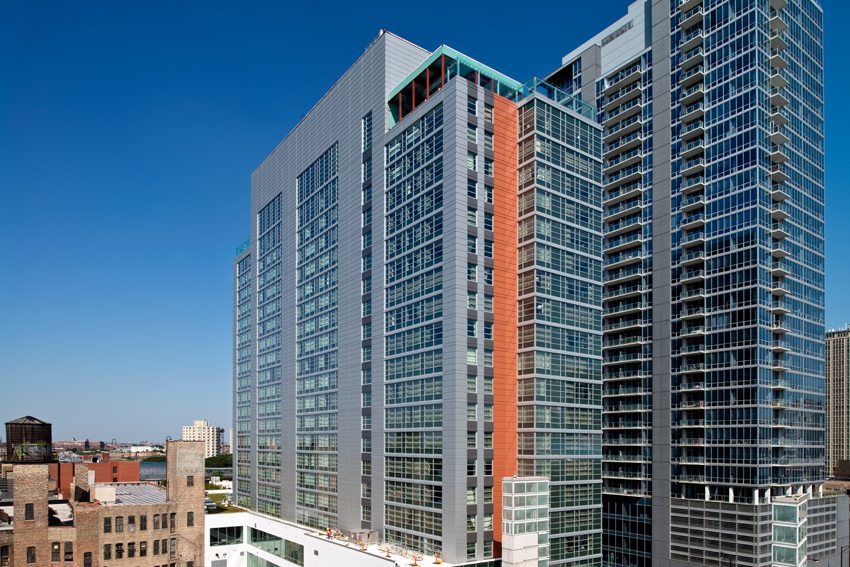
Photo courtesy of Kingspan Insulated Panels
123 East Cermak Hotels, Chicago, Illinois
Environmental Benefits
Insulated metal panels can fulfill all the required air, thermal, and water control functions to create a high-performing building enclosure. That means buildings with more consistent thermal properties, and increased occupant comfort. Much of the metal used in metal panels is recycled. And the durable nature of the assemblies creates structures that last for decades with minimal maintenance needs.
The awarding-winning T-Mobile Arena in Las Vegas was designed with insulated metal panels, which helped it achieve LEED Gold status, becoming the first sports and entertainment stadium in Las Vegas to attain LEED certification. The project was designed by the architectural firm Populous.
“T-Mobile Arena’s LEED Gold certification demonstrates tremendous green building leadership,” said Mahesh Ramanujam, President and CEO of the U.S. Green Building Council (USGBC). “The urgency of USGBC’s mission has challenged the industry to move faster and reach further than ever before, and T-Mobile Arena serves as a prime example with just how much we can accomplish.”
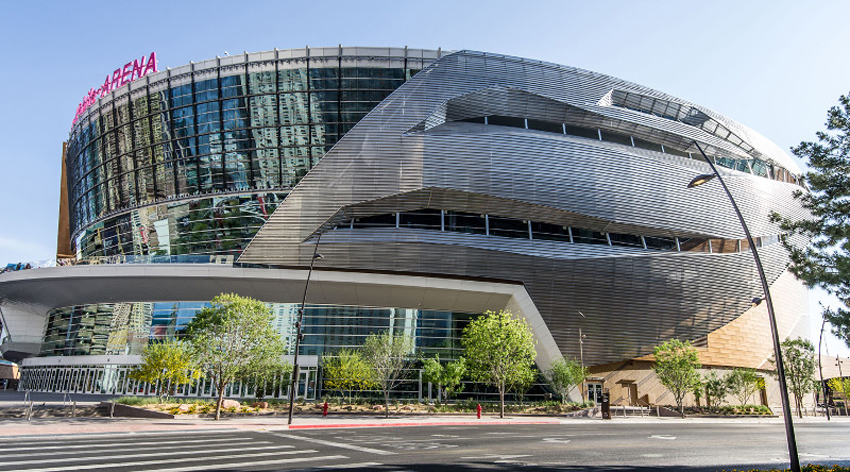
Photo courtesy of CENTRIA
T-Mobile Arena, Las Vegas, Nevada
The project includes an enormous mesh wall with a bright magenta, 9,000-square-foot LED display that overlooks the area between the New York-New York and Monte Carlo casino resorts. The LED board represents the city’s energy, while the building’s metallic skin resembles the burnt golden hues of the desert that the town is built on. The north and east sides of the venue act as a gateway to the city while the south and west are designed to reflect the hot Vegas sun.
The multipurpose arena required a building envelope that could not only withstand the hot desert weather, but also provide exciting aesthetics for the wide variety of events the facility hosts, from the biggest names in music, major UFC and boxing events, and basketball games. T-Mobile Arena is now home to the Golden Knights, the NHL’s newest franchise.
The insulated panel system provides thermal, air, water, and vapor barriers in a composite assembly to maintain comfortable atmospheres for all events. Architects paired the innovative backup panel system with custom bronze shingles, creating a building envelope that provides both performance and aesthetics.
Insulated metal panels in a gold tone complement the custom bronze shingles, while providing advanced thermal and moisture performance in a single component. Additionally, the facility showcases over 27,000 square feet of perforated screenwalls creating the fascinating mesh facade to control light passing through the curtainwall exterior.
As these projects show, the types of buildings designed with IMPs are wide-ranging. Following are a variety of applications, starting with additional sports and event facilities.
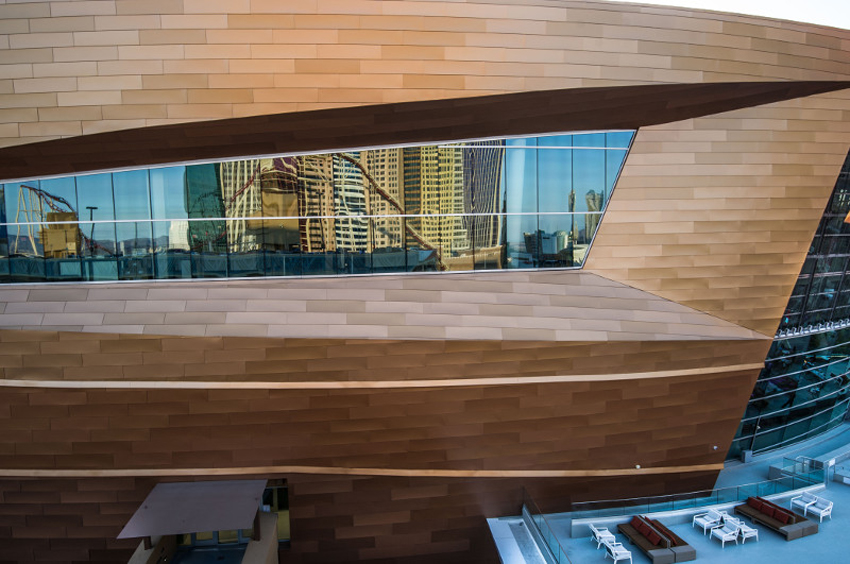
Photo courtesy of CENTRIA
T-Mobile Arena, Las Vegas, Nevada
Sports and Event Facilities
It’s hard to see how the grandeur of the Chase Center in San Francisco could have been achieved without the use of insulated metal panels. The Chase Center is a state-of-the-art sports and entertainment arena, home to the Golden State Warriors, and the site of nearly 200 events per year. Its design celebrates the beauty of the city and reflects the diversity and artistic community around it. The project was awarded a major metal building industry award.
The use of metal in the Chase Center, from the facade to the interior, is obvious and artful. Metal materials also aided the center achieve LEED Gold Certification. Metal cladding adds aesthetic contrasts of warmth and color to the exterior while capturing the modern grandeur of the interior.
“This is just wonderful,” said Stephen G. Blye, a judge in the competition. “The use of metal creates a sense of mystery and provides subtle gestures. Absolutely timeless design, very ambitious, extremely dynamic. I love it!”
The architects were Manica Architecture and Kendall/Heaton Associates.
Insulated metal panels also played a big role in construction of the new Inter Miami CF Stadium, home to Miami's professional soccer club, which was recently established in 2020 by former soccer star David Beckham. The new stadium and training facility were designed by Manica Architecture and feature 40,000 square feet of insulated metal panels. The IMPs are painted with custom black and pink colors representing the Inter Miami CF team motif. With a tight deadline, the panels allowed quick installation. The panels give the stadium a polished, professional look that echoes the modern feel of the architecture.
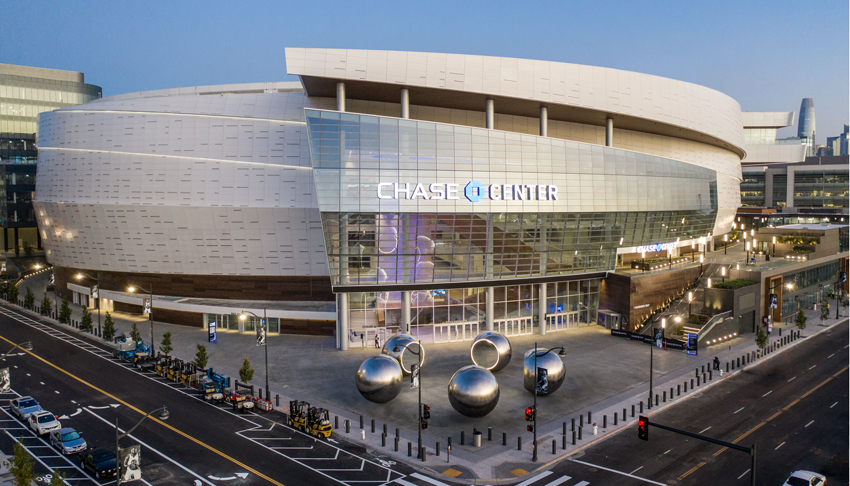
Photo courtesy of Jason O’Rear Photography/Chase Center
Chase Center, San Francisco, California
Insulated architectural panels were chosen as the main exterior of the building because of their fast install time as well as the ability to showcase the vibrant colors. The fast install time ensured that the stadium would be completed in under 10 months, a record-breaking construction time frame that was unheard of in the world of professional sports stadiums.
The panel’s advanced technology provides thermal performance in addition to their striking colors. With R-values to up 8 per inch, they are the preferred choice for large-scale buildings like stadiums, arenas, and amphitheaters. These architectural wall panels provide the desired aesthetic while ensuring a tight building envelope and energy efficiency at the same time.
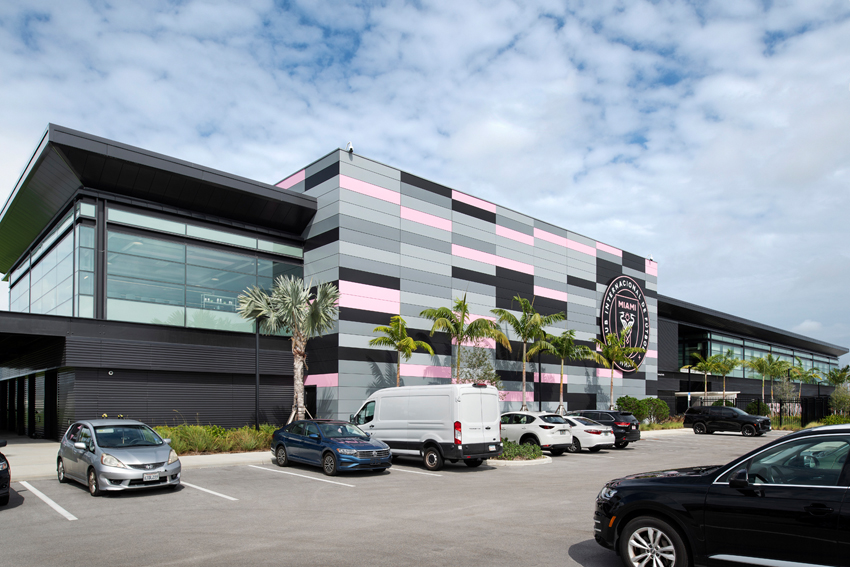
Photo courtesy of Kingspan Insulated Panels
Inter Miami CF Stadium, Ft. Lauderdale, Florida
In a very different climate, insulated metal panels helped reach goals for the design of the Rocksport Indoor Climbing Facility and Outdoor Guiding Service, a family-owned and operated business in Queensbury, New York. Rocksport’s new facility features a 45-foot-tall, two-tier inclined climbing wall. The contractor’s project coordinator explained why insulated metal panels were specified for the project, which is 50 feet tall at its highest point: “During the design phase we had to look at the constructability of such a tall building and tackle an increasingly stringent energy code,” said Todd Coffin of design/build firm Munter Enterprises. “Working at those heights and facing a mandatory blower door test on new commercial buildings by the local code enforcement, insulated metal panels were a no-brainer.”
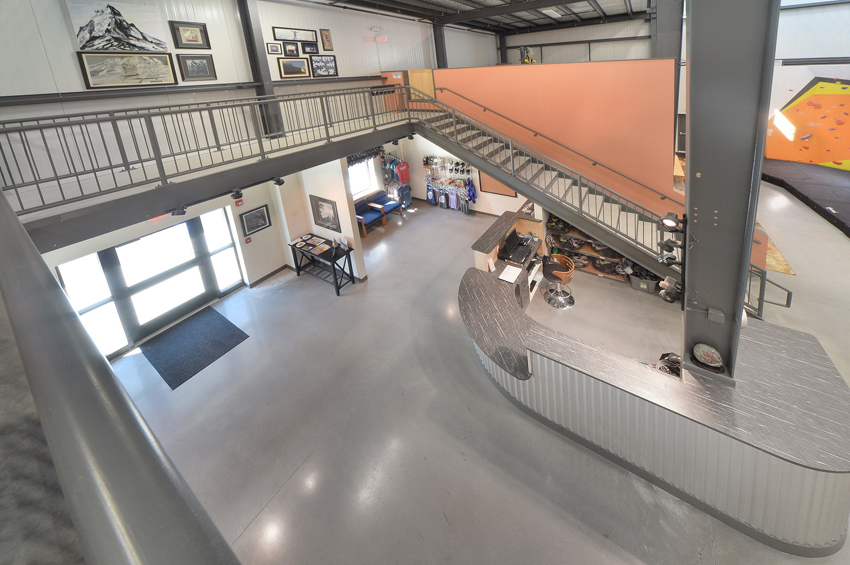
Photo courtesy of Metl-Span
Rocksport Indoor Climbing Facility and Outdoor Guiding Service, Queensbury, New York
More than 18,000 square feet of insulated metal panels were installed on the new 8,400-square-foot facility. The exterior panels are 26-gauge Galvalume with a PVDF (polyvinylidene fluoride) coating of gray and brown, while the interior panels are 26-gauge Galvalume in polyester white. Two-and-a-half inches of urethane insulation are sandwiched by the metal panels. The panels were installed vertically with double factory caulked joints.
“The insulated panels look great inside and out,” said Tom Rosecrans, Rocksport owner. “Despite the volume, the building is holding temperature great, and our utility bills are lower than expected.”
Commercial and Medical
Insulated metal panels were specified for another tall building, BMO Tower, the newest addition to downtown Milwaukee, which stands at 328 feet tall. The tower includes 400,000 square feet of rentable space and is comprised of 15 floors of offices and first-floor retail.
Architects Kahler Slater were able to deliver on both a high-profile monolithic design and on sustainability by choosing insulated metal panels to enclose parking on the bottom eight levels of the otherwise all-glass, 25-story office tower.
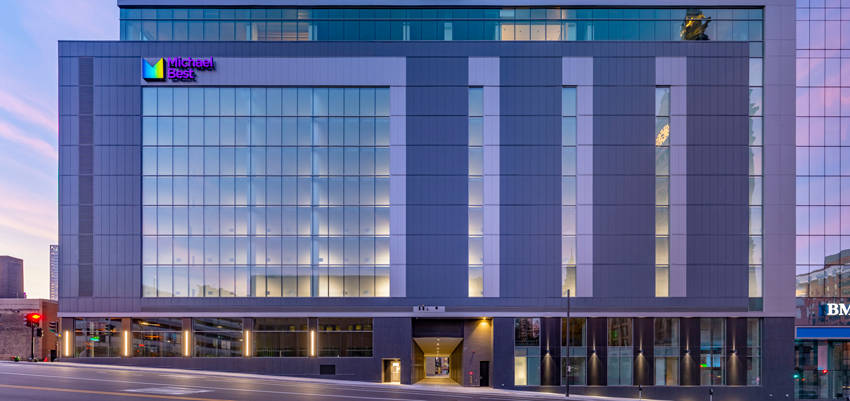
Photo courtesy of Metl-Span
BMO Tower, Milwaukee, Wisconsin
To provide protection from the elements—particularly the cold, wind and snow that is common in Wisconsin—architects needed a product that would provide an optimal barrier and create a smooth finish.
Insulated, concealed fastener architectural panels allowed for a clean sightline and a seamless look due to the interlocking nature of installation. To prevent water infiltration, designers added a composite band to transition from the glass curtain wall to the metal panels on the 12th floor.
BMO Tower features architectural metal panels in charcoal, satin nickel, and gray. The panels have a polyurethane core that is encapsulated by two steel facings for an all-in-one building envelope solution. This eliminated the need for addition insulation and created efficiencies on the job
In addition, the impermeable faces and built-in thermal breaks of the metal panels maintain insulating values for the life of the building. This significantly lowers heating and cooling costs, key to success in achieving Green Building Initiative certification for sustainable design, construction, and operations.
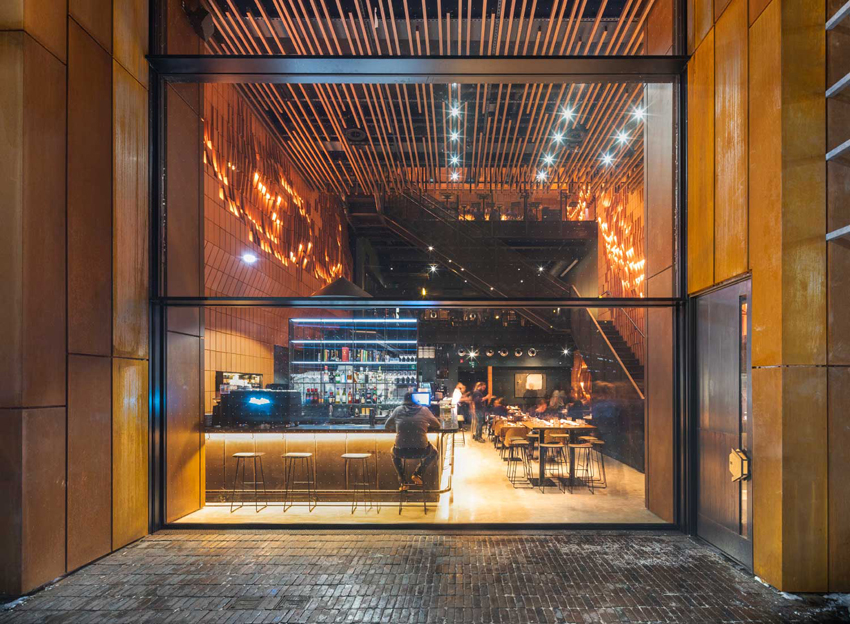
Photo courtesy of Kingspan Insulated Panels
Gusto 501, Toronto, Canada
Cost savings and reduced construction time were priorities for the Gusto 501 project in Toronto’s Corktown. Gusto 501 is a multilevel restaurant and bar dining experience with a theatre style atmosphere of terracotta walls encompassed by a large garage door stylized facade.
With a narrow 6,700-square-foot building space, owners Gusto 54 Restaurant Group called upon the Partisans architectural firm in Toronto. Partisans selected an insulated metal wall system with a rib profile panel of mineral fiber insulation to help achieve the theatrical building design challenge. The all-in-one solution of a single source panel system allowed for fast installation in a tight space. The mineral fiber panels provide a fire resistance rating up to three hours.
The universal barrier wall system provided the client not only reduced construction time and costs without the need of multiple trades, but it also allowed the desired design flexibility and imaginative freedom.
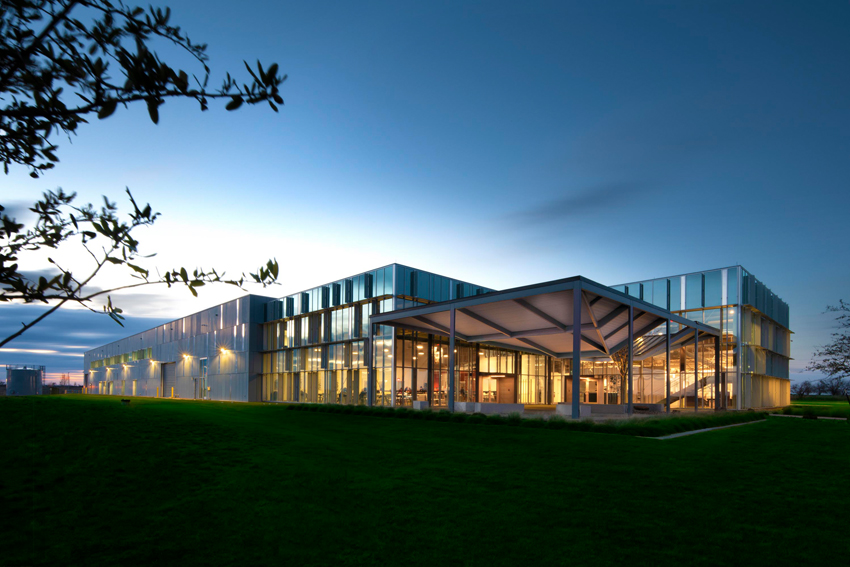
Photo courtesy of Kingspan Insulated Panels
DynaEnergetics, Blum, Texas
In Blum Texas, the award-winning DynaEnergetics’ headquarters is a state-of-the-art manufacturing and office facility. Its exterior reflects the high-precision nature of the company’s products as well as its parent company’s European roots. The exterior’s natural finish metal accentuates the landscape of the surrounding flat rural plains. Vertical and horizontal aluminum sunshades, coupled with reflective glazing, control heat.
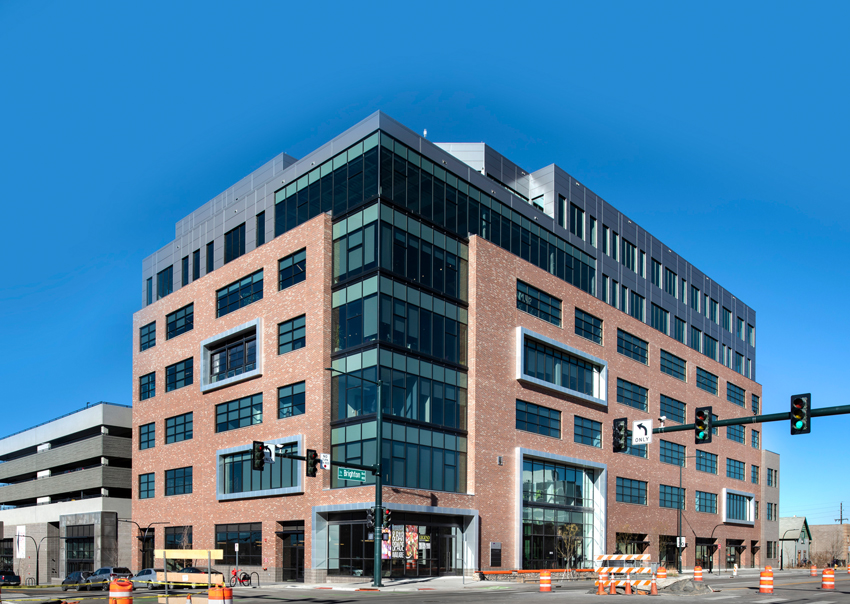
Photo courtesy of Kingspan Insulated Panels
Catalyst Health-Tech Innovation, Denver, Colorado
The building, designed by Arch11, Inc. in Denver, won an award in a competition sponsored a metal building organization. Most of the building’s facade is clad in insulated metal panels.
“The use of metal gives the building a conspicuous texture and depth,” said Yen Ong of 5G Studio Collaborative, one of the competition judges. “I appreciate how expressive they made every element of this building.”
In Colorado, insulated metal panels helped created a sophisticated building in a hub in Denver’s bustling River North District, an area rich with businesses, restaurants, artist studios, and more. Catalyst Health-Tech Innovation was created to be an industry integrator, bringing together major healthcare systems, doctors, universities, nonprofit groups, and startups.
The seven-story, 190,000-square-foot building was designed by The Beck Group. The exterior of the building is described as blend of historic Colorado and chic, based on results from a 50-question survey sent to 500 people in the community.
Part of that industrial chic look includes the use of glass, brick, and insulated metal panels. More than 14,000 square feet of IMPs finished in pewter were used on the exterior. The panels deliver a flat, modern look while meeting the demand for a high-performing building envelope. The panels are GREENGUARD Gold certified.
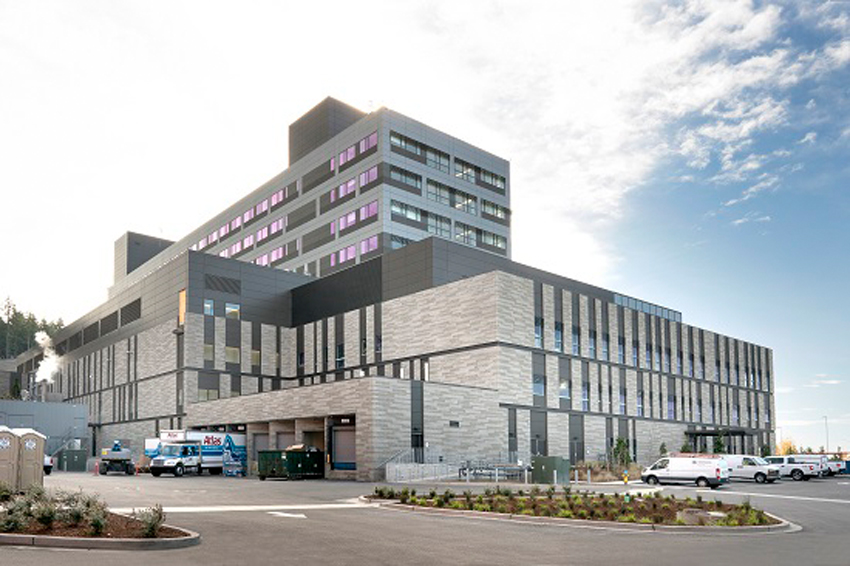
Photo courtesy of Kingspan Insulated Panels
St. Michael Medical Center, Silverdale, Washington
Insulated metal panels helped achieve the sustainability goals for the recent $500 million, 500,000-square-foot acute care expansion of the St. Michael Medical Center (formerly Harrison Medical Center) in Silverdale, Washington. It was a project that builds on a caring legacy started by the Harrison family more than a century ago. NBBJ Architects designed the project.
The nine-story, light-filled facility can boast that it is the most energy-efficient hospital in the state. Ketul Patel, CEO of project owner CHI Franciscan Health (now part of Virginia Mason Franciscan Health), is quoted in the Puget Sound Business Journal: “The facility was…built to use 50 percent less energy than the average hospital in the Pacific Northwest, use 36 percent less water and save the carbon output of the equivalent of 700 homes.”
To help meet the ambitious design and sustainability goals, Balfour Beatty, the general contractor, worked with a manufacturer that could deliver the insulated metal panels, windows, sunshades, and louvers that would make the project a success.
In fact, that manufacturer provided project management for the insulated metal panels, single-skin panels, and integrated windows, as well as louvers and the design of a special, customized sunshade design that the architect wanted but that didn't exist. In this case, the architect wanted individual blades attached vertically to the window, rather than the typical sunshades that attach at the top like an eyebrow.
For the walls, flat panels were specified along with a ribbed profile panel and 1-inch reveals. One interesting feature on the front of the building is the incorporation of foam insulated metal panels with vertical ribbons of CMU block, which looks like stone. From a design perspective, it goes back and forth—panel, window and then the vertical section of stone and then panel, window, etc. This achieved the architect’s vision.
Education and Municipal
In Flint, Michigan, sleek and colorful insulated metal panels helped make the Flint Cultural Center Academy an appealing destination for the community. The academy offers experiential learning to students in kindergarten through sixth grade alongside the programs offered by the Flint Cultural Center Institutions.
When designers began planning the facility, they knew they wanted to showcase the flexible learning environment and embrace the new technology in education. THA Architects Engineers envisioned a building envelope with an innovative look to deliver the modern design of FCC Academy, which would feature curved and straight-wall sections. Once they did their homework, architects chose insulated metal panels.
“Our goal was to create an ultra-contemporary expression that was going to emphasize the technological advances in education, and the sleek metal panels reflect that high-tech look we were striving for,” said architect Jeff Bennett.
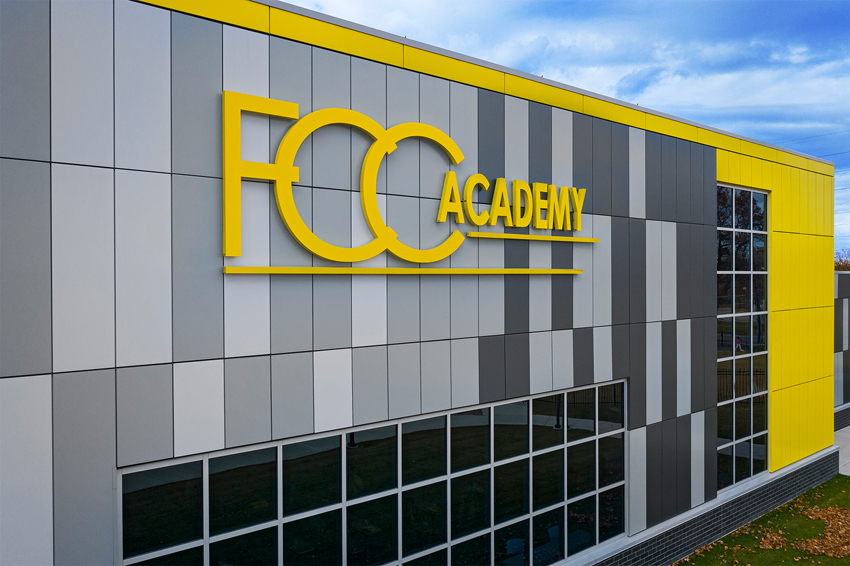
Photo courtesy of CENTRIA
Flint Cultural Center Academy, Flint, Michigan
The manufacturer developed curved panels for the academy to make the design vision a reality. The unique curved wall allows for southern exposure and serves to separate classrooms from the part of the building that houses the gym and cafeteria. Exterior walls for those two sections have linear panels.
The 3-inch panels met new energy code requirements in Michigan using a singular wall panel solution while also delivering a visual expression not yet seen in Flint.
The building’s external wall features 28,500 square feet of insulated metal panels in four different colors. The panels are integrated with a brick base. Architects also specified a special flashing to build a sill condition at the transition point and highlight the metal panels.
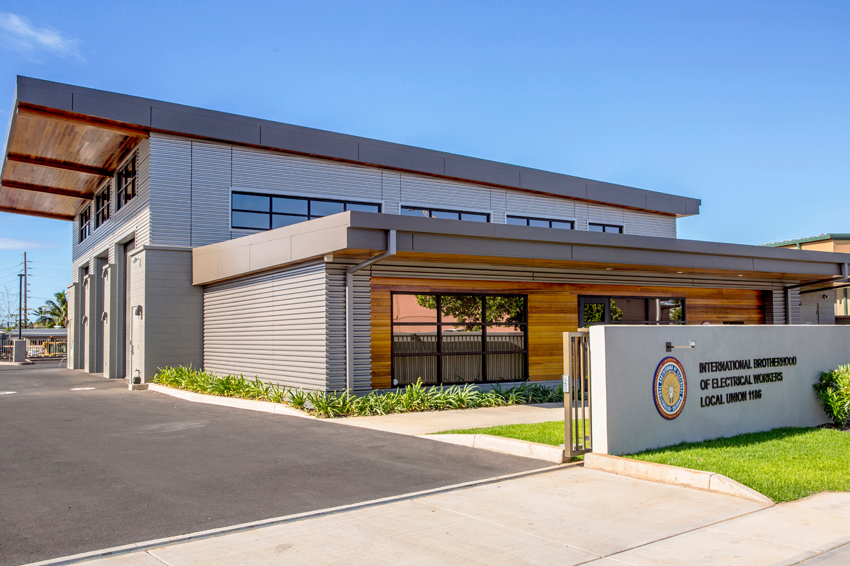
Photo courtesy of Kingspan Insulated Panels
International Brotherhood of Electrical Workers, Kahului, Maui, Hawaii
Metal panels also helped achieve several aesthetic and functional goals in Hawaii. With a growing membership, the International Brotherhood of Electrical Workers (IBEW) local 1186 union in Kahului, Maui, needed a multipurpose space capable of housing offices and a training facility all while having an aesthetically pleasing look appropriate for hosting various social functions.
A pre-engineered structural frame was chosen to facilitate ease of installation, increasing faster build times of both roof and wall. Insulated metal panels quickly clad the walls while standing-seam roofing panel’s mechanical seaming process saved on labor costs and ensured superior air and weather tightness.
The metal panels married well with the native western red cedar wood. The sleek, clean ribbed metal is warmed by the richness of the soffit and entryway accent panels.
Said Jeffrey Lee, associate with the AHL architectural firm in Honolulu, “I particularly liked the panels for the ribbed appearance and the metallic finish. I wanted to have the ribs of the panels wrap the corners of the building while maintaining a clean look. The main reason we used (the manufacturer’s) products was due to the tight schedule, but the appearance was the real selling point.”
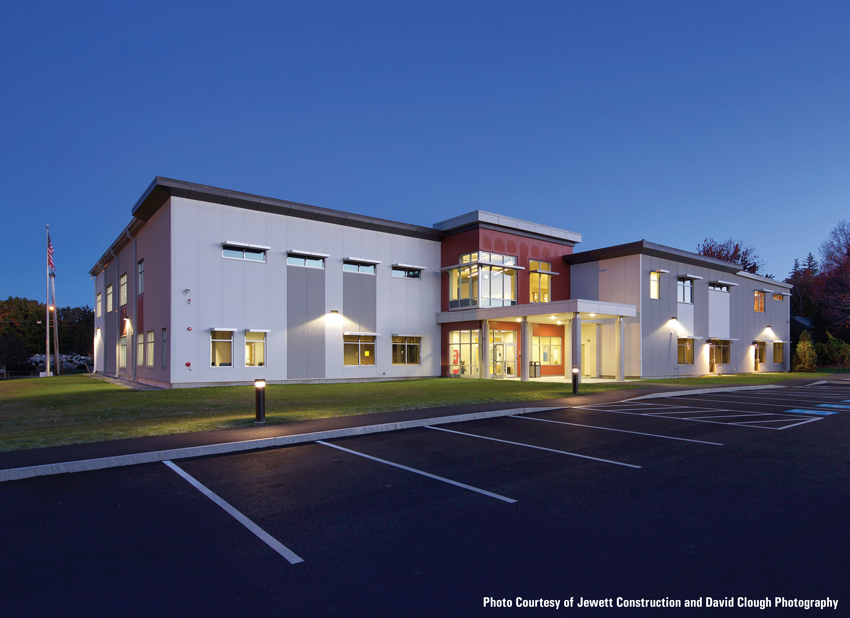
Photo courtesy of Jewett Construction and David Clough Photography
YMCA, Exeter, New Hampshire
Each new YMCA facility is constructed focusing on the needs of the community it serves and the YMCA in Exeter, New Hampshire, is no different. The 33,000-square-foot facility features fitness studios, weight and cardio rooms, a gymnasium, indoor track, and a community room.
Almost 17,000 square feet of insulated metal panels make up the envelope for the building. Brian Hoey, president of Brookside Co. Inc. of Stow, Massachusetts, oversaw construction by Barrett Siding of Londonderry, New Hampshire, including the erection of girts and installation of insulated metal panels.
“We had some tough February snowstorms to deal with and some extremely cold days,” Hoey says. “Still, we were able to get everything done in about four to five weeks. The panels were laid out so they were lined up with where they wanted the windows. That’s the advantage of working with IMPs. With the exception of some of the extremely cold days, we were able to keep working to get the building closed in by mid-April. Some other products require warmer weather to build.”
The exterior of the Exeter YMCA is comprised of three profiles, including 8,388 square feet in a textured white, 3,436 square feet of a striated wall panel in terracotta, and 5,089 square feet in a light gray. All three profiles are coated with an architectural exterior coating that offers a masonry aesthetic often desired by architects and building owners. Some of the panels have a stucco-like appearance, while others offer the appearance of finished precast concrete.
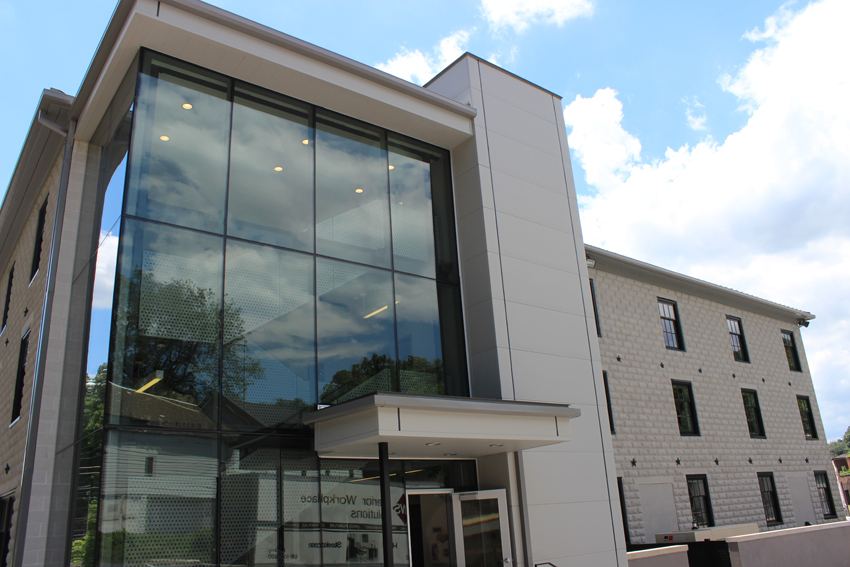
Photo courtesy of ATAS International
Lafayette College’s Bushkill Commons, Easton, Pennsylvania
“Insulated metal panels provided us with an aesthetic that made the facility not look like a metal building,” says Brittany Blin, an associate with Bruce Ronayne Hamilton Architects of New Ipswich, New Hampshire. “We didn’t want it to stick out as a cold building, but a gathering place where families feel welcome. Specifying panels in different colors really warms up the appearance.”
Insulated metal panels also serve functional and aesthetic needs for historic buildings. The retrofit of Lafayette College’s Bushkill Commons in Easton, Pennsylvania is an adaptive reuse of an existing building originally built by the Speer Lumber Company of Easton in the early 1900s. Over the year, the building had fallen into disrepair. The original post and beam structure wrapped in a masonry facade had survived a few fires as well as the wrecking ball. It would eventually get a new life by being converted to new office space for educational and municipal purposes.
Careful consideration was given to the impact of insulating and conditioning the building as it was historically an open structure. Interior insulated wall panels were built, waterproofed with a breathable liquid membrane, and installed from the interior of the building. The installed system allows for a comfortable interior workspace in the historic building.
Transportation and Aviation
In a city as creative and innovative as Nashville, a new airport concourse just had to be superior in form and function, a goal that insulated metal panels made possible. While the musical city hits high notes with travelers from around the world, the airport struggled to keep pace with unprecedented passenger volume. BNA Vision, a multiyear expansion plan, included a brand-new Concourse D that encompassed six domestic gates and terminal space to accommodate future growth. As BNA Vision looked to the future, energy efficiency was top-of-mind to reduce the airport’s carbon footprint.
Fentress Architects specified nearly 60,000 square feet of insulated metal panels for the project, which allowed them design freedom while providing the thermal efficiency that reduces energy consumption. The insulated metal panels provide an all-in-one barrier against air and water penetration.
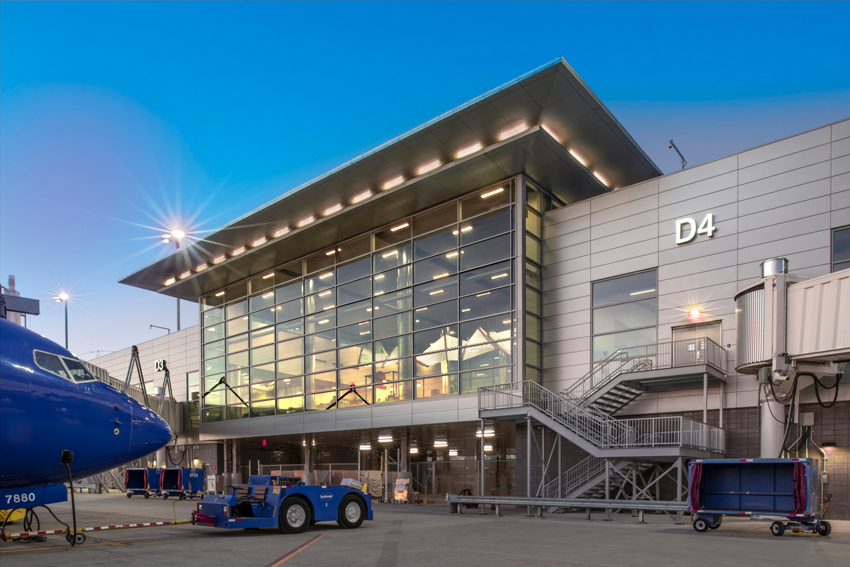
Photo courtesy of Kingspan Insulated Panels
Nashville International Airport, Nashville, Tennessee
The specified panels contain 28 percent less embodied carbon when compared to traditional industrial claddings, already putting BNA on the runway to a more sustainable future. The project was finished in just 25 months, thanks in part, to the insulated panels’ speed of build, reducing the number of trades needed on site.
“The new Concourse D gives us more capacity for commercial air service to meet the rising demand for travel to and from Nashville,” said Doug Kreulen, Metropolitan Nashville Airport Authority president and CEO. “At the same time, it’s an impressive, energy-efficient structure reflective of the world-class airport that is taking shape.”
Architects chose a champagne gold tone for the insulated metal panels. The closed-cell insulation technology in the panels is GREENGUARD Gold certified and classified as Red List Free, putting passenger health and safety first. The project achieved a LEED Silver certification.
The new Williston Basin Airport in Williston, North Dakota is another winner of a design competition that showcases the use of metal in exceptional buildings. The new airport, designed by Alliance Architects, is more than double the size of the old airport, a needed increase to serve the booming economy. To reflect the natural landscape of the airport’s surroundings, metal was selected to achieve the look of limestone while also being a cheaper, significantly lighter, and more environmentally friendly option.
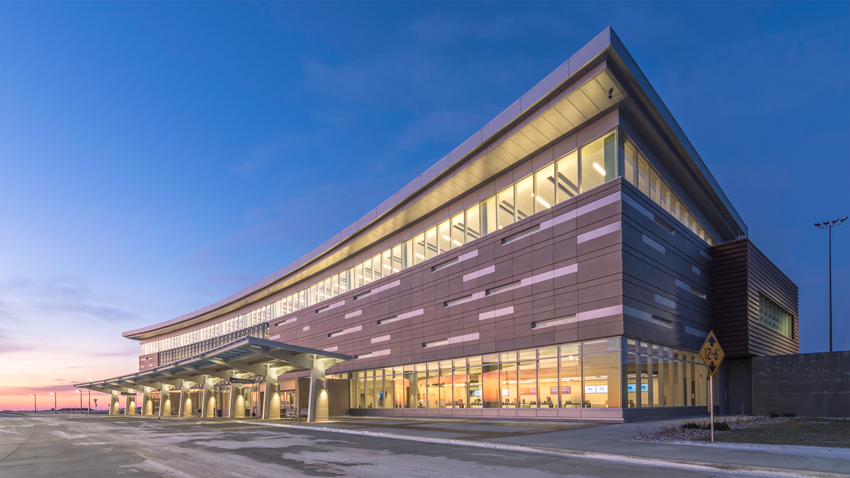
Photo courtesy of Brennan Photo + Video
Williston Basin Airport, Williston, North Dakota
“This is a great exploration of metal,” said Stephen G. Blye, an architect and one of the competition judges. “The patterning is strong and done very effectively. Metal is used in a lot of different textures and forms, but it remains cohesive throughout and works well for a greater whole.”
A rainscreen facade was used to create a 10,000-square-foot enclosure at the main entrance elevation and north/south returns. The airport uses tens of thousands of square feet of metal products, including perforated screenwalls, corrugated panels in a rust-colored finish, metal panels in flat and embossed finishes of silver and dark bronze colors, and single-skin wall panels in dark bronze. Alliance Architects designed the project.
In Anchorage, a state-of-the-art two-bay hanger was needed to meet Alaska Airlines fleet additions for the next few decades. Construction speed was a unique challenge and especially important for this hangar due to Alaska’s shortened construction season. Generally, construction stops in October and doesn’t begin again until March or April.
A challenge that comes with hangars is that a large portion of the building is an opening—in this case, a giant 286-foot-wide by 47-foot-tall door was a giant puncture in the envelope. Code in Anchorage requires continuous insulation, and architects had to ensure that the massive hangar doors would not dramatically affect the temperature inside the hangar.

Photo courtesy of Kingspan Insulated Panels
Alaska Airlines, Anchorage, Alaska
One of the reasons insulated metal panels were chosen for this hangar was speed of construction. Using IMPs eliminated the need to do temporary enclosure, which would have needed to be heated. Once the product is on site, panels are easy to install to quickly create a building enclosure.
The continuous insulation and high R-values that IMPs provide, along with the energy systems in the building, prevent a constant battle with the necessary hole in the side of the building. A 4-inch panel was used and there is no other additional insulation.
Sustainability was another goal for the project that IMPs helped with, as the building went through the LEED precertification process. Using a single product for cladding and insulation reduces a tremendous amount of waste.
Using IMPs on a building this large also helped keep costs down by reducing the number of trades needed during construction, as well as reducing layers of operation. Immediately after installation, it was a finished assembly both inside and out.
According to Jason Gamache, principal architect, and director of sustainability at MCG Architecture: “Important factors in choosing metal panels for this project were schedule, speed, durability, efficiency and the one-shot envelope.”
The Ark at New York City's John F. Kennedy (JFK) International Airport sets the standard in world-class, luxury accommodations... for animals. The 178,000-square-foot cargo terminal will change the way passengers and corporations transport pets and livestock, particularly dogs, cats, horses, cattle, and birds. The $48-million facility houses nearly 50 horse stalls, a cattle pen, a veterinary clinic, and spa-like facilities to pamper household pets.
Designing interior spaces for animals presented a unique set of challenges to the architectural design team at Gensler of New York. The Ark pet center features grooming stations and spaces tailored to the recreation of each species, such as splash pools for dogs and climbing trees for cats. Livestock, however, need a cycle of fresh air constantly, placing an emphasis on adequate ventilation and environmental control.
"Gensler is accustomed to designing airports with an eye to fostering well-being for people," says Gensler senior associate Cliff Bollmann, director of aviation and transportation. "The Ark at JFK posed a unique design challenge for us: to create a place that could ease and simplify the sometimes-complex process of transporting animals by plane."
The Ark replaces a smaller kennel and quarantine facility called VetPort, which suffered from a poor location at JFK International Airport some distance away from the heavily traveled terminals. A veteran designer of airports, Bollmann and his team from Gensler targeted an abandoned cargo facility that offered both a convenient location and adequate space. The building was to be converted approximately 40 percent into an animal handling operation, with the balance returned to freight transfer.
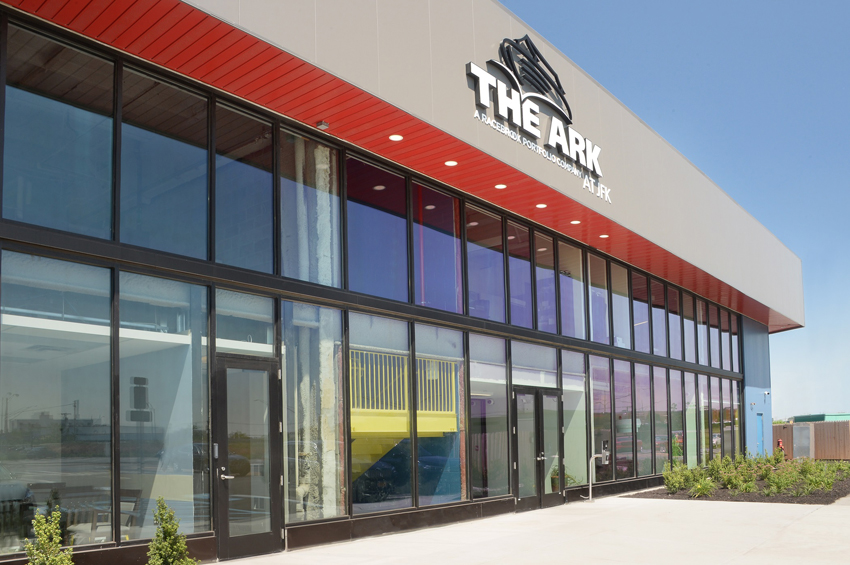
Photo courtesy of Metl-Span
The Ark Terminal at JFK, Queens, New York
While the architectural team initially hoped to repair the existing cladding to make it watertight and improve insulation, a suggestion arose to reskin the vacant hangar with an insulated metal panel wall system as a cost and time saver.
"Gensler specified leaving the existing interlocking panel system by adjusting, repairing and adding similar panels to suit the new layout—then adding an elaborate insulation, framing and interior finish to meet energy and fire codes," said Bruce Foster, secretary/treasurer of installer Stuart Berger Construction Corp.
The Ark at JFK includes nearly 14,000 square feet of insulated metal wall panels in three distinct profiles. The juxtaposition of flat and lightly corrugated exterior panels lends the project a modern, sleek aesthetic that perfectly suits the facility's end use: an amalgam of healthcare, hospitality, and transportation.
Designers incorporated both 2-inch and 4-inch panel thicknesses for thermal performance in the airside cargo terminal. The exterior of the high-performance building envelope blends blue, tan, and charcoal gray hues. One of the benefits of the panel's single-component construction is a finished interior liner. The interior panels, painted in white, are exposed throughout much of the facility, providing a clean, contemporary appearance.
"In this project, the interior liner, high insulation factor and speed of installation were all favorable attributes of the IMP solution," Forster says. "The fact that the new panels are a high-performance finish and look great is a bonus. The system also saved money."
Designed Roofs
IMPs are the roofing solution that provides greatest insulation, simplest maintenance, and longest life coupled with quickest installation for low- and high-rise commercial and industrial roofing applications. The essentially two-step installation process limits exposure to accidents, reduces the number of installation steps and materials required and provides a roof with superior insulation properties that can last more than four decades. Here are some notable examples.
Consider this truism: If you make it simple, they will build it. This was the case for Vail Elementary School in Temecula, California.
To simplify the entire process of constructing a K-12 school building, contracting firm TLS Choice (Total Learning Space) of Santa Ana, California, has developed plans for building systems of various sizes, already prechecked by the Division of the State Architect (DSA). The CUUBE by TLS Choice is a pre-engineered building, using pre-approved building plans that utilize pre-sourced and pre-verified materials and components, including insulated metal roofing and wall panels.
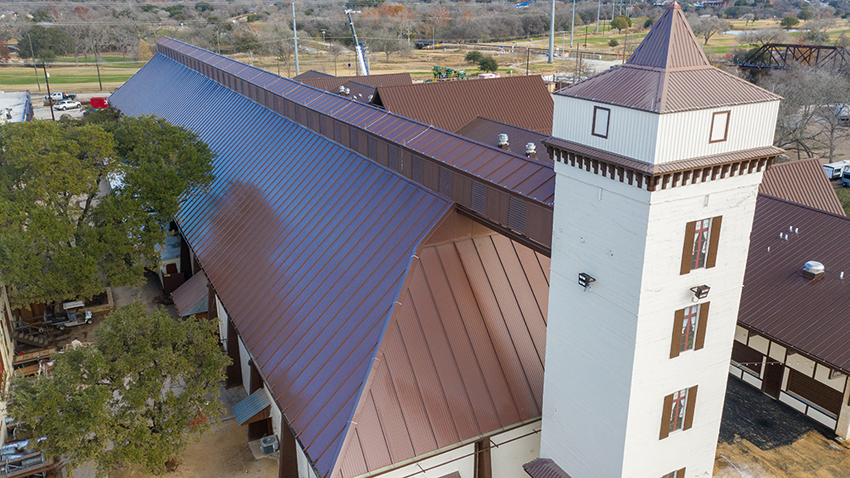
Photo courtesy of Metl-Span
Vail Elementary School, Temecula, California
The wall panels for Vail Elementary were in a durable exterior finish in stone color to provide the appearance of stucco. The 36-inch-wide panels with a 2-½-inch urethane core boast an 18 R-value. Pascal Steel Corporation of Encinitas, Calif., installed 5,766 square feet of wall panels and 6,844 square feet of insulated roofing panels in a terracotta finish. The 42-inch-wide roof panels are 3 inches thick.
“Because all CUUBE buildings have gone through the DSA approval process for the structural components, they do not have to be reevaluated when submitted for the site-specific plan review,” says Corey McElhinney, project manager at TLS Choice. “Using one of our pre-engineered CUUBE DSA-approved PC plans can save the district up to six months.”
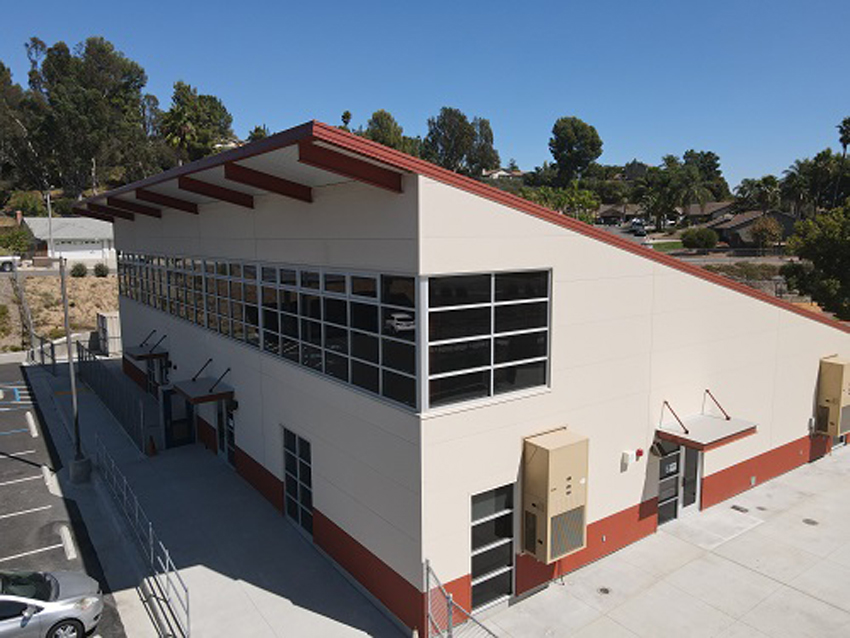
Photo courtesy of Metl-Span
Wurstfest, New Braunfels, Texas
Wurstfest is a popular annual celebration of German culture in New Braunfels, Texas, located between San Antonio and Austin in the Texas Hill Country. Just days after the successful November 2019 event wrapped up, a fire damaged the large facility that hosts the 10-day festival. With less than a year to reconstruct the 27,000-square-foot facility for the 60th annual event in November 2020, there was no time to waste.
Because there was a deadline to meet, insulated metal panels (IMPs) were specified for the new Wurstfest facility. IMPs can be installed faster than other materials for walls and roofing.
Kevin McClellan, AIA, RID, Senior Associate at MarmonMok Architecture of San Antonio, and Mitch Schuetz, director of commercial production at Earnest Roofing of New Braunfels, were part of the design-build team led by Byrne Construction Services.
“We went with insulated metal panels on this project because it was just easier and quicker than installing insulation and a single skin panel,” McClellan said. “Ultimately, installing a structural panel also gave us better performance, a better system, one that met the short- and long-term goals for the project. In a truly collaborative way, we, as a team, thought through the best performative solution and landed on the IMP.”
There was a lot of work to be done before panels could be installed. “We were dealing with a 100-year-old building,” Schuetz said “Nothing is square, nothing is plumb, nothing is straight, nothing is true. We spent one full day popping lines on one side of the building to make sure we could get those panels installed straight and another full day popping lines on the other side. After that, once we got the first panel in place, it all went together the way it should have.”
Conclusion
From their humble beginning as a cost-effective and easy-to-install building assembly, insulated metal panels have evolved into one of the most innovative and exciting building systems that architects can specify. When the same products are used for such a vast range of applications—from the grandest entertainment venues to landmark commercial hubs to the most modest structure—it’s obvious a shift has entered the artful field of architectural design. It’s likely that the use of insulated metal panels will continue this trajectory into the future.
Kathy Price-Robinson writes about building and design. Her remodeling series “Pardon Our Dust” ran 12 years in the Los Angeles Times. She specializes in buildings that are durable and resilient to climate disruptions, as well as products and designs that provide shade in hot climates. www.kathyprice.com




































